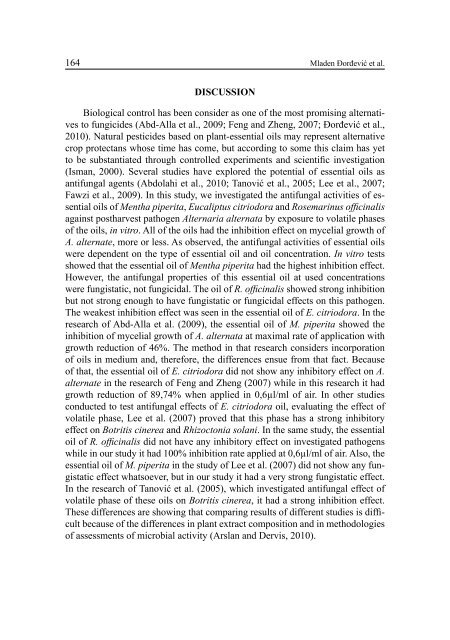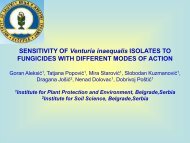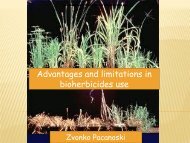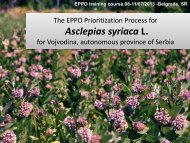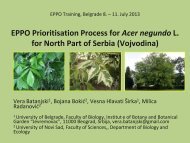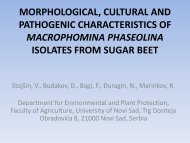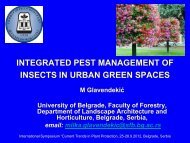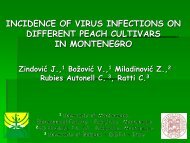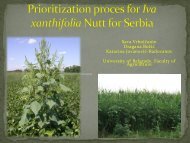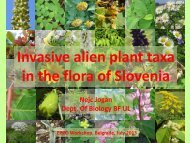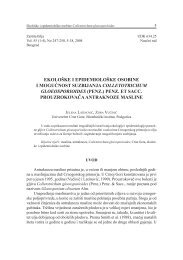ZAŠTITA BILJA PLANT PROTECTION
Vol.62 (3) - Izbis
Vol.62 (3) - Izbis
Create successful ePaper yourself
Turn your PDF publications into a flip-book with our unique Google optimized e-Paper software.
164 Mladen Đorđević et al.<br />
DISCUSSION<br />
Biological control has been consider as one of the most promising alternatives<br />
to fungicides (Abd-Alla et al., 2009; Feng and Zheng, 2007; Đorđević et al.,<br />
2010). Natural pesticides based on plant-essential oils may represent alternative<br />
crop protectans whose time has come, but according to some this claim has yet<br />
to be substantiated through controlled experiments and scientific investigation<br />
(Isman, 2000). Several studies have explored the potential of essential oils as<br />
antifungal agents (Abdolahi et al., 2010; Tanović et al., 2005; Lee et al., 2007;<br />
Fawzi et al., 2009). In this study, we investigated the antifungal activities of essential<br />
oils of Mentha piperita, Eucaliptus citriodora and Rosemarinus officinalis<br />
against postharvest pathogen Alternaria alternata by exposure to volatile phases<br />
of the oils, in vitro. All of the oils had the inhibition effect on mycelial growth of<br />
A. alternate, more or less. As observed, the antifungal activities of essential oils<br />
were dependent on the type of essential oil and oil concentration. In vitro tests<br />
showed that the essential oil of Mentha piperita had the highest inhibition effect.<br />
However, the antifungal properties of this essential oil at used concentrations<br />
were fungistatic, not fungicidal. The oil of R. officinalis showed strong inhibition<br />
but not strong enough to have fungistatic or fungicidal effects on this pathogen.<br />
The weakest inhibition effect was seen in the essential oil of E. citriodora. In the<br />
research of Abd-Alla et al. (2009), the essential oil of M. piperita showed the<br />
inhibition of mycelial growth of A. alternata at maximal rate of application with<br />
growth reduction of 46%. The method in that research considers incorporation<br />
of oils in medium and, therefore, the differences ensue from that fact. Because<br />
of that, the essential oil of E. citriodora did not show any inhibitory effect on A.<br />
alternate in the research of Feng and Zheng (2007) while in this research it had<br />
growth reduction of 89,74% when applied in 0,6µl/ml of air. In other studies<br />
conducted to test antifungal effects of E. citriodora oil, evaluating the effect of<br />
volatile phase, Lee et al. (2007) proved that this phase has a strong inhibitory<br />
effect on Botritis cinerea and Rhizoctonia solani. In the same study, the essential<br />
oil of R. officinalis did not have any inhibitory effect on investigated pathogens<br />
while in our study it had 100% inhibition rate applied at 0,6µl/ml of air. Also, the<br />
essential oil of M. piperita in the study of Lee et al. (2007) did not show any fungistatic<br />
effect whatsoever, but in our study it had a very strong fungistatic effect.<br />
In the research of Tanović et al. (2005), which investigated antifungal effect of<br />
volatile phase of these oils on Botritis cinerea, it had a strong inhibition effect.<br />
These differences are showing that comparing results of different studies is difficult<br />
because of the differences in plant extract composition and in methodologies<br />
of assessments of microbial activity (Arslan and Dervis, 2010).


